Now that we are in Namibia and in a semi-desert environment, Mila and I did something really weird last night. We put on these things called socks, for the first time since 2011 (seriously, none of us have worn socks since December). Socks are gloves for your feet – they keep them warm.
Africa
Yesterday we visited British scientists Krys Golabeck and Neil Jordan at The Botswana Predator Conservation Trust, based 2 hrs north of Maun at ‘Dog-camp’ in Concession NG34, just below the Moremi National Park. The Trust is one of the longest running conservation research projects in Africa, and one of a handful of its caliber worldwide. Founded as the Botswana Wild Dog Research Project in 1989 by Tico and Lesley McNutt, today it covers all the large carnivore species in Botswana.
The project we visited is focused on the nine packs of wild dogs that roam in Moremi, from Kazikini all the way up to Xakanaka. Wild dogs are a critically endangered species.
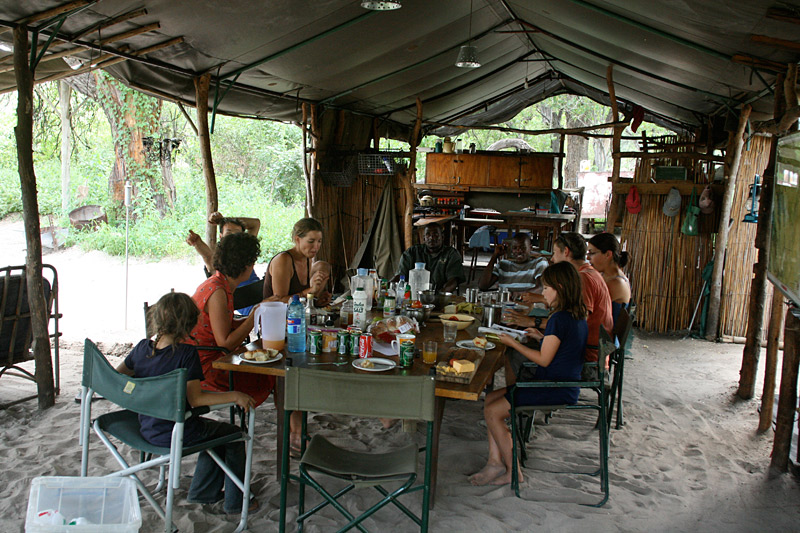
There are 2000 – 3000 wild dogs left in Botswana – about half of Africa’s (hence the world’s) population. They are crepuscular (active at dawn and dusk) – admired for their efficient co-operative hunting technique, and loved for their co-operative social behaviour. Each dog’s marking is unique. When approached by humans, they will often approach, curious. Wild dogs inspire – ask Ralph.

The work we heard about focuses on bio-boundaries. It aims at deciphering the complex chemistry of natural scent marks used by free ranging wild dogs to signal territorial boundaries.
At the bush camp they collect and monitor wild dog territorial urine markings, and the laboratory 100 kms south in Maun is working to sample and replicate the scent. The goal is to apply this chemistry to the management of the species in increasingly human dominated, fragmented habitats.
Wild dogs have huge territories – a home range can be more than 1000km2. A pride of lions can be 250km2. Chobe is 11,700 km2. Moremi is 5,000km2. Central Kalahari Game Reserve is 52,800km2 (the second largest national park in the world). In the Central Kalahari, lion reign supreme, and they attack wild dogs whenever encountered. There are hardly any dogs left there.
For obvious reasons, the larger the required home range, the more vulnerable dogs are to a decrease or fragmentation in territory. For example, if the corridor between Moremi and Chobe parks (currently hunting concessions where dogs can roam) becomes used for farming, (not impossible – Botswanan ministers apparently own a large percentage of the country’s cattle) it would be catastrophic for wild dogs.
When the dogs are forced out of parks/protected areas, they encounter humans (and disease). Usually wild dogs have a moving territory and so whilst they may kill livestock, they move enough to spread their hunting across many farms. They are not be a big threat to any individual farmer, and not easily trackable. They are however, very vulnerable to farmers when they stay in a den for an extended period, which they do for the first 2 or 3 months of their pups’ lives.
The future of wild dogs is tragically precarious. But one thing we can know for certain – without organisations like the BPCT spearheading research and conservation, our great grandchildren, maybe even our grandchildren, will only find wild dogs in zoos.
We’re in Ghanzi (in western Bots). We were planning to go and find lions & cheetah in Mabuasehube – but landed up seeing so much in the Kalahari that we decided to head home through Namibia instead.
Finally heading south again … we’re on our way home…
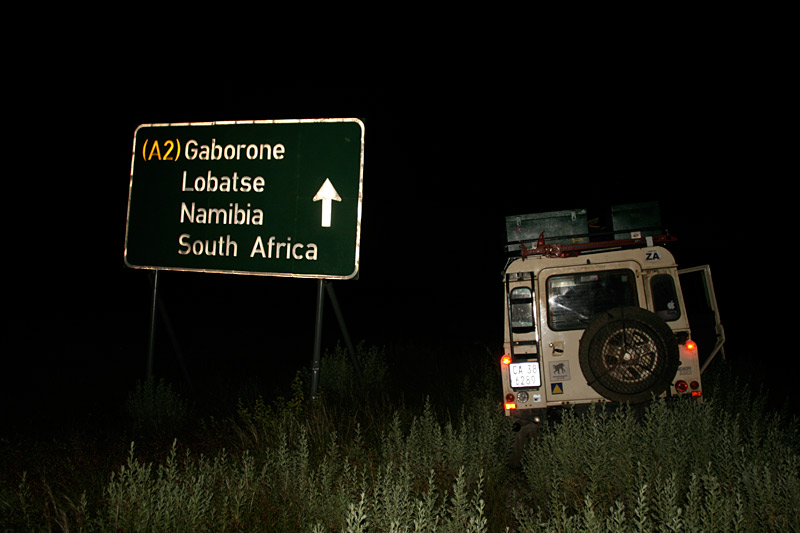
For 2 days in the Kalahari we teamed up with a wonderful Portuguese/Dutch couple to find lion & cheetah in the northern Kalahari. Here’s an edited/composited version of Anna’s rooftop footage.
The Cheetah are all at Letiatua Pan, where we’re over 200km from the closest town. Great to have another vehicle with us. Between us we had the place to ourselves.
The Lion were at Sunday Pan. We’d spotted them at sunrise and Helio and Anna had staked them out all day while we rested in camp (and Bea finally finished her Social Studies) in Deception Valley 30 kms away. The footage shows 5 beautiful, healthy females emerging onto the pan to hunt as the light faded. A huge privilege to be there alone with them. Generations and generations of these wonderful creatures have roamed this veld. Alas, these might be amongst the last…
We met Neville and his wife Wendy at Pomene Lodge in southern Mozambique. Along with being two of the most generous-spirited people we have ever met, Neville is an expert on ocean life, born of his love of the sea and years of being a dive master all over the world. We were excited to find out that Neville had actually discovered a new species of fish, a (delicious, rare and, may I add, intelligent) goatfish that is now named after him.
Interview by Bea (10) and Mila (8).

What is your fish called?
Mulloidichthus ayliffe. (Neville’s surname is Ayliffe)
The first part of the name is the genus, then the species (lowercase).
Where are they found?
They are found all the way up the east coast of Africa, and as far as the Red Sea.
Where did you first see it?
In the Coral Gardens in Sodwana Bay in northern Zululand near Mozambique, with schools of flame goatfish.
How did you discover it was a new goatfish?
I wasn’t sure if it was a different fish, or just a flame goatfish trying to look different from other flame goatfish. The blue banded snapper also lives with flame goatfish. Predators like kingfish prefer to eat goatfish and ignore any fish with blue lines. The Ayliffe goatfish has blue bands so it looks like a snapper, and so is left by kingfish. Ayliffe goatfish are slightly bigger than flame goatfish because they live longer.
What does it eat?
It’s a special fish. It’s got a beard, that’s why it’s called a goatfish. The beard is an external tongue that it uses for fluffing the sand, where it will find something to eat. It eats crustaceans.
Is it a yummy fish?
It’s said in Roman times goatfish were traded for their weight in silver because they are sooo delicious. (Neville looks especially chuffed to be named after a scrumptious fish)
Would you eat it?
No! I wouldn’t eat a fish named after myself!
Were you surprised when you first discovered the new fish?
No, it had puzzled me for quite a long time. They are nearly the same as other goatfish, but different, so it was not a sudden thought – the idea grew on me.
Are you trying to find out all the differences between a flame goatfish and your one?
I’m not, but the scientists are. Ichthyologists have been measuring the new fish. They count the number of scales from head to tail and side to side. They count the number of fins and teeth and look at the DNA (the DNA testing is done in Canada).
How do you get a fish named after you?
You have to prove it’s a new fish. Some ichthyologists were diving with me a few times a year at Sodwana Bay (in South Africa). I told them I thought there was a new species of goatfish. Once they saw the DNA was different from the flame goatfish, it was easy to say it’s a new fish and the scientists then got the whole naming procedure going.
Will it be in fish guide books from now on?
It will be soon, but it’s not a common species. A whole shoal has never been seen together, at most 12 or 13 are seen together.
Are you proud to have a fish named after you?
Very much so! Every dive master dreams of it.
Do you prefer being on land or water?
I love being in the water. Both though.
Do you think there are other undiscovered fish?
Well (twinkle in his eyes) I’ve been looking at the blue banded snapper. There are some with yellow eyes and white bellies, usually they have grey eyes and grey bellies. Sooooooo…..
Neville and his eponymous goatfish.

We’ve just returned from what feels like the highlight of our trip; a week of big skies and big cats in the Central Kalahari Game Reserve (CKGR).
With no rain for over a week, the roads in were extremely good. Bumpy, but no deep sand or mud. Due to its remoteness (nearest town over 200km away) one needs to be entirely self-sufficient – you have to take in your own water, wood, tomatoes and chocolate. 120L of diesel, 145L of water, several kg of biltong. People have asked about what ‘stuff’ we have, here is an outline…
——————————————————————————————————————————————————
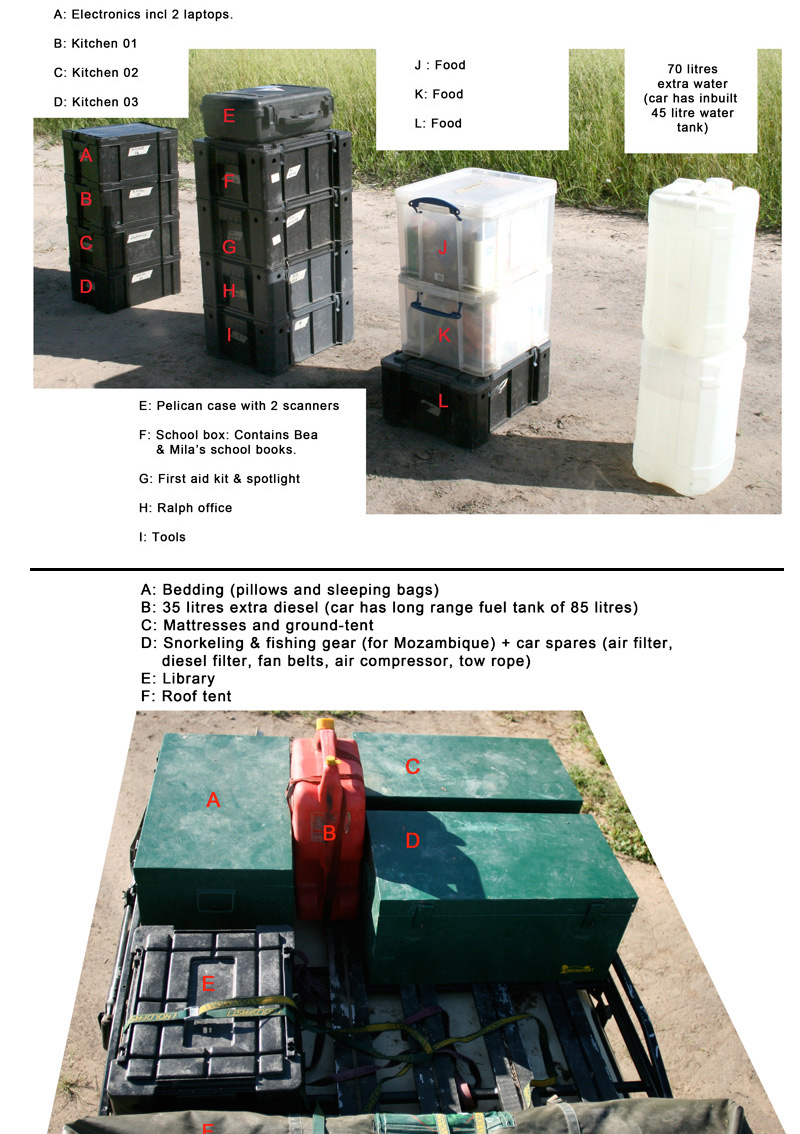
OK – enough from Ralph!
This leg is always exciting because the CKGR is a very beautiful, big, silent wilderness.
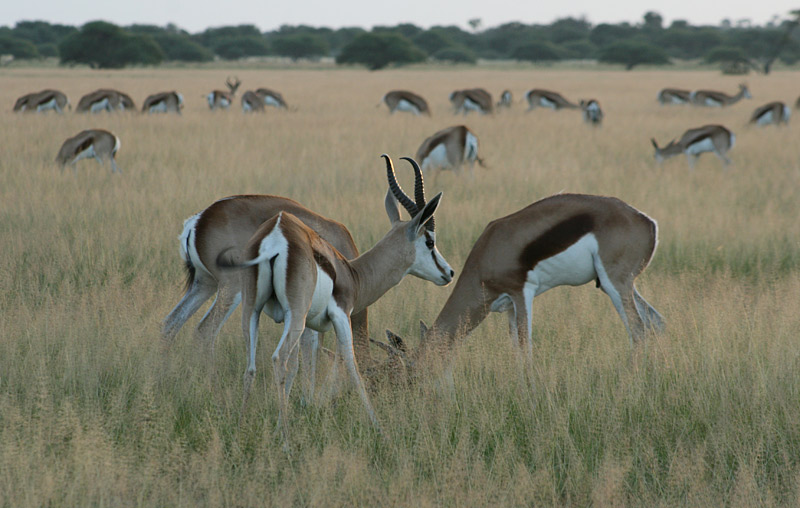
What also makes CKGR feel special is that one can sit on the roof of the Landy without fear of a jolly good telling off (although it is not strictly allowed). Who ever is on the roof is the lookout, with a walkie talkie that inspires a lot of silly chit-chat. The landscape feels very different from the roof.
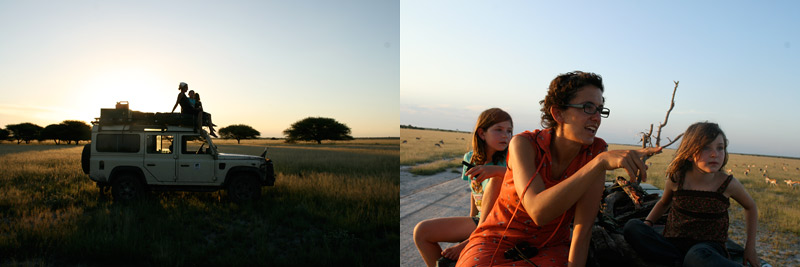
Magic happens at dawn and dusk so we drove out each morning before sunrise, and returned to the bush to look for animals again as evening fell.

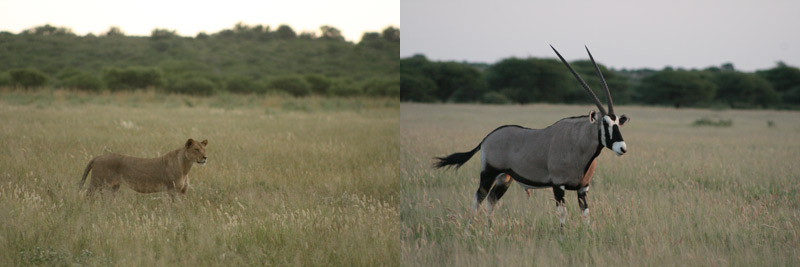
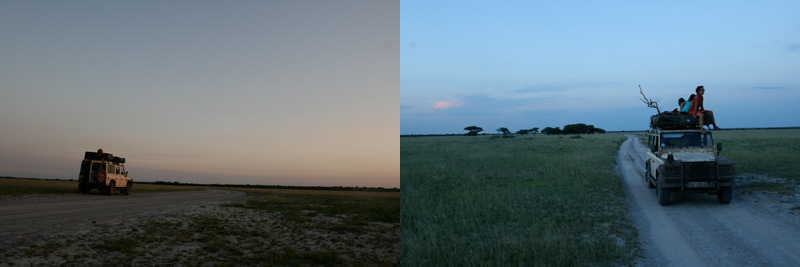
The middle of the day (11am-4pm) was spent in camp. It was extremely hot but we had shade and set our fridge to icey cold. We set up a very comfortable camp, finally using every awning, peg and rope we brought along. Ralph’s favourite camp, ever! Camps here are patches of cleared bush where one is allowed to sleep. There are no gates, no fences, no taps…
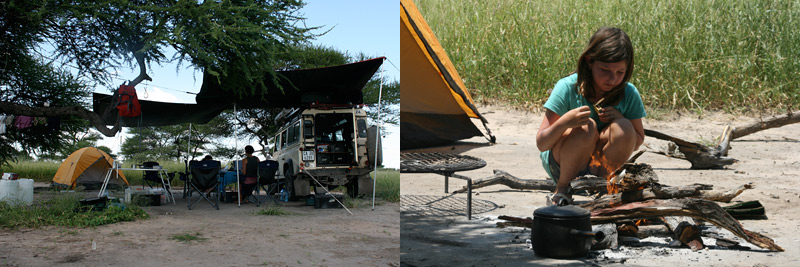
Yesterday Mila and Bea poured a cup of water into the sand in our camp, and within minutes it was covered in hundreds of butterflies. Mila monitored this butterfly home, while Bea finished off her Social Studies.
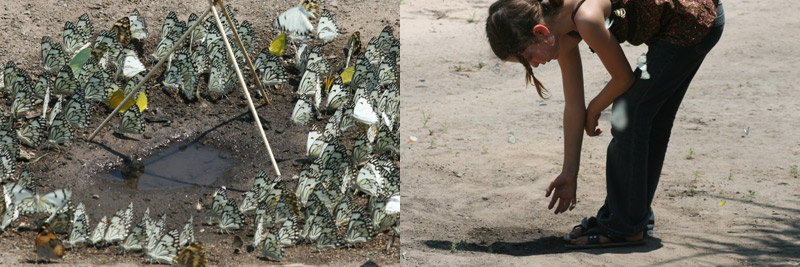
How absurd and magnificent to be in several thousand square miles of pristine Africa, where the lions FAR outnumber the human souls. During our four day stay we saw only 5 other vehicles. We made friends with the inspiring Portuguese/Dutch couple Helio & Anna, also in a Cape-Town Gumtree purchased Landie. With breaks to earn money, they have been living in a car for 16 years. But what a life!
Together our two CA-Landies staked out three cheetah under a tree, near the Lehitau Pan, for 8 hours. On this game drive, we saw 9 cheetah (2 groups of 3 with females, one group of 3 males), all within 5 km of each other. It’s really unusual to see so many groups so close, although female cheetah have overlapping territories.
It was novel to be game watching with another car, one vehicle on watch while the other drove a couple of km off in search of diversion and some shade. When Ralph spotted the third set of cheetah, about 5 hrs into the hot day, groans of “Cheetah pah!” were almost audible. Like bloody buses. Anyway Anna walkie-talked us back to the stake-out point (simulate strong Dutch accent): “There are coming… 14 giraffes!”.

Lion and other cats are nocturnal, but cheetah hunt by day while other predators (who steal their kills) sleep. However the cheeth only emerged from under the tree as the sun set, when we were rewarded with these three beautiful creatures, who’d been nervous at day break, walking beside our car at ease, even resting in the long shadow of Mpandangare.

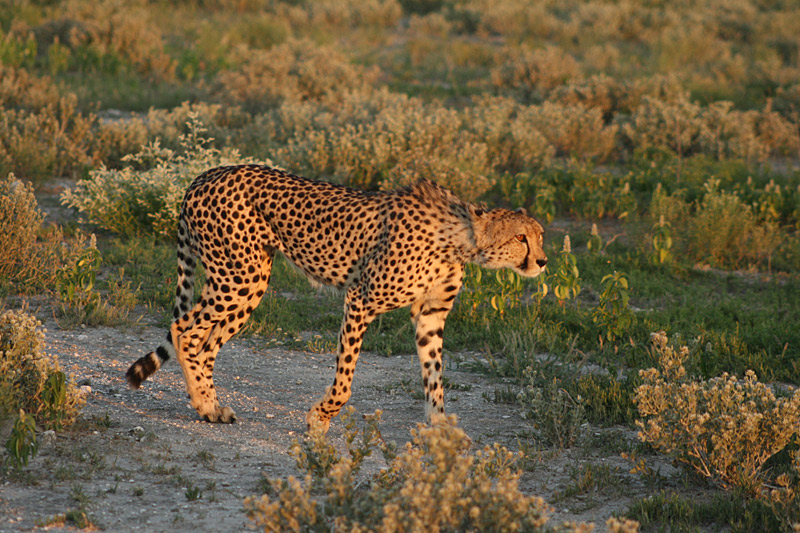
Although it’s not universally fascinating, for the record we saw:
Day 1, Deception Valley: a thwarted cheetah kill on a small gemsbok and five huge lionesses in the dark seemingly swimming through the long grass
Day 2, Lehitau: one old male lion and nine cheetah incl. an abandoned cheetah hunt of a steenbok
Day 3, Sunday Pan: five slightly smaller lionesses at dusk fanning out to hunt gemsbok
and a partridge in a pear tree.
Mila even spotted an upside-down giraffe (extremely rare at this time of year).

Lions are typically active 2-4 hours in 24. It didn’t really feel like that to us, as the lions calling to each other kept us up all night. Lots of yawning happens at stakeouts.
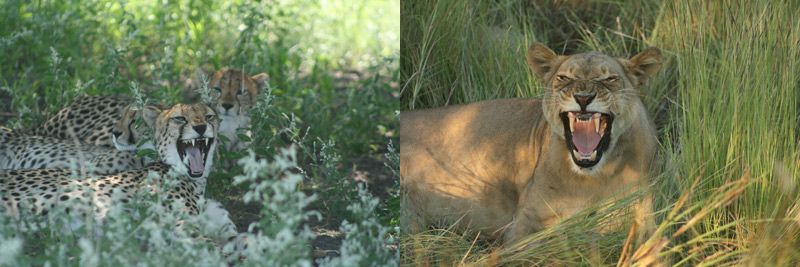
This is the road to Sunday Pan, an island of syringa trees and what rests in their shade.
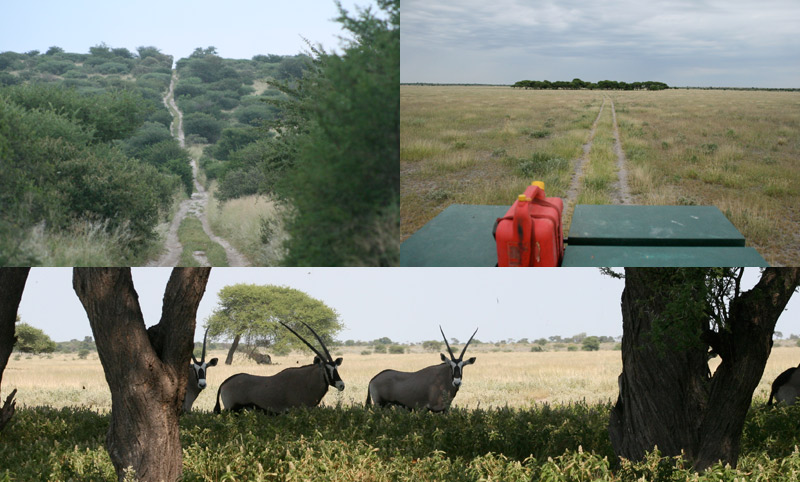
As ever, we left Deception Valley at sunrise, Lisa on the roof STILL excited by secretary birds, Ralph STILL on the lookout for lions, all of us looking forward to real shade and water, but sad to be leaving. Forty km down the sand road out of the park, Ralph saw fresh lion spoor on the road. For miles we followed the ghost of this huge solitary lion, to just by the gate where the tracks disappeared into the bush. Part of our hearts went with him.

Recent film of Nxai Pan with Oren. You’ll notice that YBHB’s are not the brightest birds. This particular fellow was pecking at himself in the mirror. When the jackal walks past near the car, in the background are 2 cheetah at a zebra kill (jackals don’t go near cheetah kills because the former are quick enough to catch them). Later in the film the lion have chased off the cheetah, and mister jackal is coming closer…
Lion-whisperer Oren pops by for the weekend, bringing two walkie talkies, five sticks of biltong, seven playful lions, a zebra migration, two beautiful cheetah, an unfortunate baby zebra, two hungry new black-maned lions, three jackals and seventeen vultures. And bat-eared foxes.
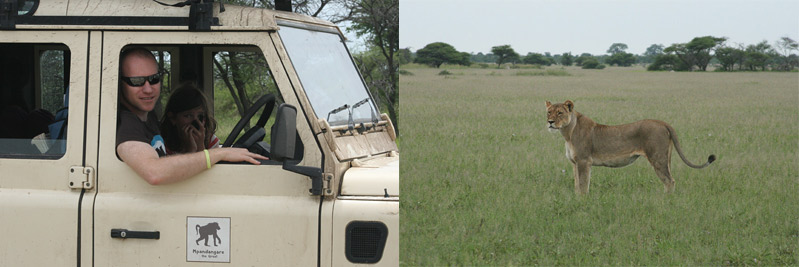
On our first game drive comes the walkie talkie crackled call from Oren on the roof one always wants to hear: “Leeus, leeus, 9 o’ clock”. We followed them for a mile across what felt like an overgrown golf course.
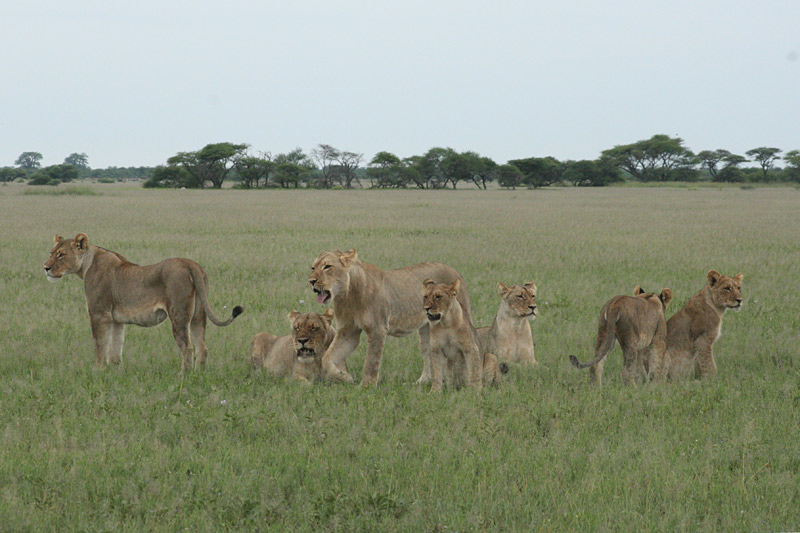
Like a gentle wave of fur, they rolled and tumbled and mock attacked their way as they went. On the eastern side of the pan, thousands and thousands of migrating zebra.
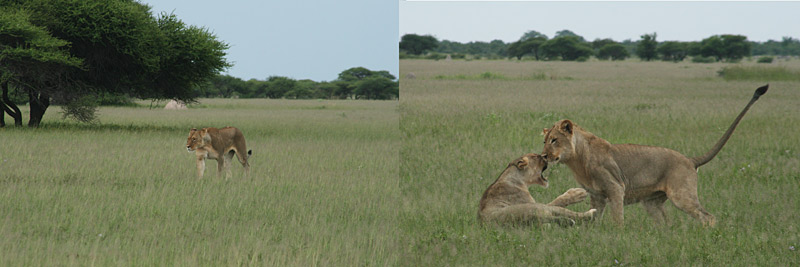
Also that morning we found two cheetah on the southern pan road. We followed them for a while, but eventually they disappeared into the Mopane. But that wasn’t all that disappeared. So to did our Gopro camera. In all the excitement (jumping up onto the roof etc) it must have fallen out of the car – so no more Gopro films on this blog alas…
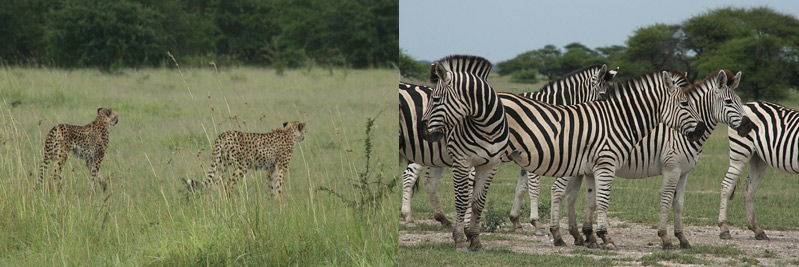
We found the cheetah late afternoon, a few miles north, with a zebra kill. Then, unbelievably, two MASSIVE male lions arrived on the scene, sat down lazily, looking at the cheetah every now and then, and spent the rest of the afternoon sleeping in the grass while the cheetah ate.
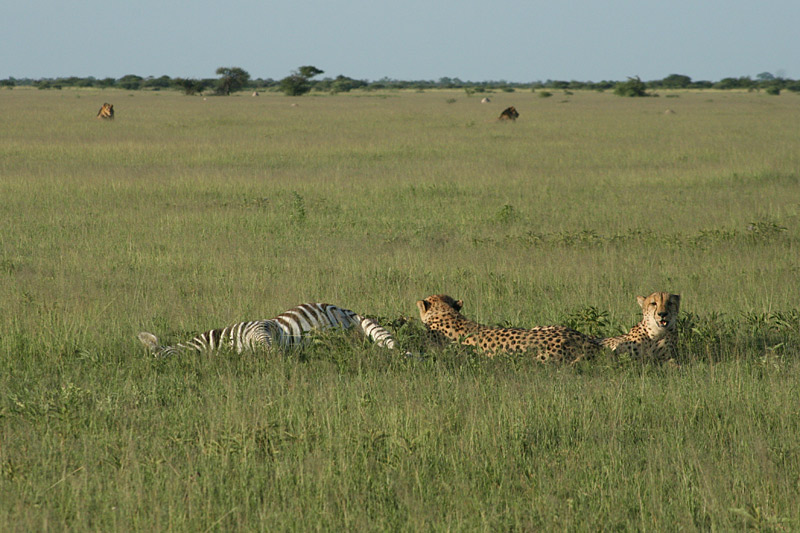
At sunset the lions awoke from their slumber, chased the cheetah away, and while the jackals circled, devoured the entire young zebra in half an hour.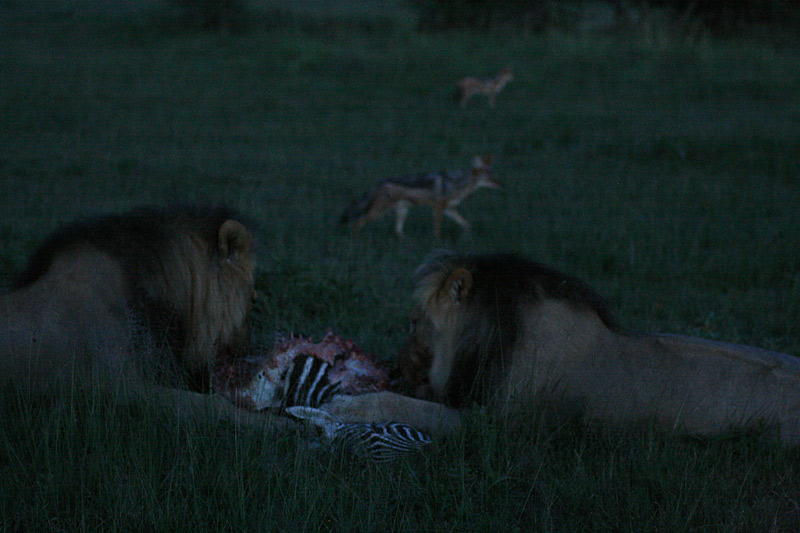
Apart from one other vehicle, we were extremely lucky to have Nxai Pan to ourselves – this is the joy of coming in the rainy season. Oren we are sad to say goodbye! What will we do without you?
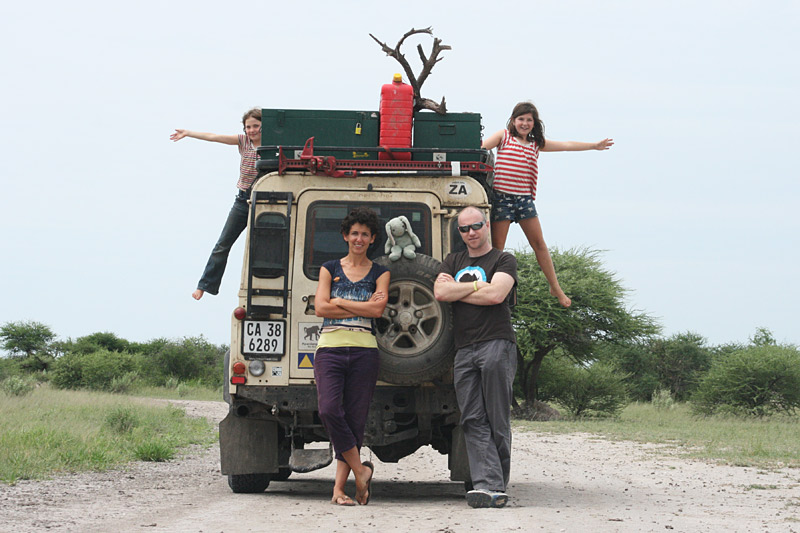
We’ve been hugely privileged to spend 5 days in my spiritual home, Savuti, right in the heart of Chobe in Botswana. Remote, tough to get to, painfully beautiful and very wild.
I’ve been coming here since I was seven and such a pleasure to see Lisa, Bea and Mila getting into it. Everyone up at 5am, itching to hit the deep rutted tracks – 8 eyes hungrily tracking the fresh lion spoor – the smells of the bush and sunrise gold pouring into our brilliant muddy car (that has been our boat-like home for the last 2 months), simply not a better way to spend the first few hours of a day.
True to the Savuti experience, we had elephants in the campsite almost constantly. And although we didn’t manage to spot them in the thick rainy-season grass, two very loud prides of lions near us from the second night onwards.
Because it’s wet there are very few other vehicles at this time of year, and wonderful camaraderie: Everyone delighted to have made it through the mud, everyone hyper-alert because of what’s around, everyone sleep-deprived because of the noises at night, and everyone excited at being there.
The fly-in safari lodge round the river bend currently charges US$1,200 per per person per night, so being able to access the area in one’s own vehicle is certainly a great privilege. With Botswana’s diamond resources dwindling and tourism becoming more increasingly important, I expect the East African model will follow, where independent travel eventually gets priced out.
The Department of Wildlife and National Parks has really got it right with these camps: self-drive access only, total self-sufficiency (but there is water), no fences round the camps, a formula virtually untouched since Chobe was formed. It results an extraordinary experience, which is what has made Chobe so famous.
Photos below: Chobe north gate 2008 and 2012.


Carmine Bea-eaters soar past the car,
Eating as they go,
Swiveling and swooping all around,
What a fabulous show.
We were sitting on top of the Landrover driving along slowly on the sand road. Suddenly about 5 magnificent Carmine Bee-eaters with their scarlet chests came soaring past us and caught some grasshoppers in their beautiful beaks. The glamorous birds were only a few feet away from us and if we wanted to we could have reached out and stroked one, except we would have been speared by their long sharp beaks.
There’s nothing more beautiful in nature, and there’s nothing more beautiful than nature.